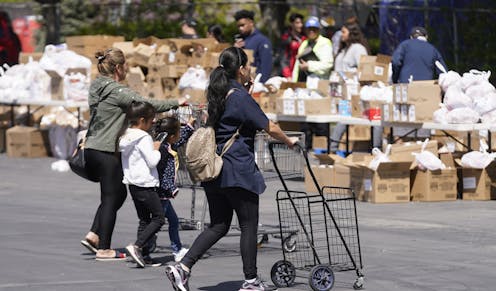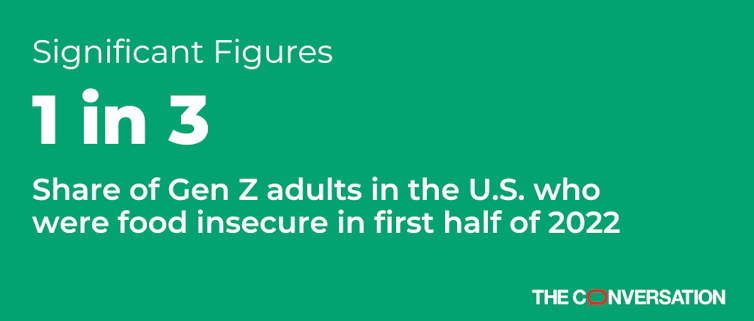Why food insecurity among Gen Z is so much higher than for other age groups
About a third of American adults in Generation Z lack the money or resources needed for reliable access to nutritious food.


Adult members of Generation Z are experiencing food insecurity at over twice the rate of the average American, according to our latest consumer food survey. In fact, about 1 in 3 Americans born from 1996-2004 have had trouble affording enough food in 2022.
That compares with fewer than 1 in 5 millennials and members of Generation X, and fewer than 1 in 10 baby boomers.
We run the Center for Food Demand Analysis and Sustainability at Purdue University, and every month, through our Consumer Food Insights survey, we query over 1,200 Americans with the goal of tracking national food security as well as many other behaviors, attitudes and preferences related to food.
Food insecurity means having a lack of money or other resources for food. And when food insecurity surges, it can take a long time for affected populations to recover. After the Great Recession that ran from 2007 to 2009, food insecurity increased by 34%. It took a decade for food insecurity to drop to its pre-recession levels.
With COVID-19, food insecurity increased again, particularly among the most vulnerable groups in society, such as seniors and households with children.
But it also increased for members of Gen Z, who were the most likely to face unemployment due to the pandemic. And for those attending college, the pandemic reduced essential food services on campus and increased the number of students dropping out of school.
Now, with inflation soaring at the fastest pace in 40 years, those who lost jobs during the pandemic and college students with fixed incomes must stretch their limited resources even further at the grocery store.
We have found that education, income and race are three of the biggest factors driving food insecurity among America’s youngest generation. Members of Gen Z without a college degree or who make less than the federal poverty line have a much higher risk of being food insecure – over three times the risk of other Gen Z households. The rate of food insecurity among Gen Z Black and Hispanic households is almost double that of white and Asian households.
Other research shows that factors like marriage and owning your own home typically improve food security. Since young people typically aren’t married or own a home, Gen Z by and large isn’t benefiting from these factors.
Additionally, full-time college students are generally not eligible for the Supplemental Nutrition Assistance Program, formerly known as food stamps. Although student eligibility has been expanded during the ongoing COVID-19 public health emergency, the paperwork required to apply can potentially discourage young people who have much less experience navigating the government bureaucracy.
Our survey also shows a significant portion of Gen Z – 30% – has relied on free groceries from a pantry, church or other charity.
Prices for food consumed at home are currently jumping at over 12% a year. That’s the fastest pace since 1979. Our survey data only reflects some of these recent price gains, so it’s unclear yet how much this will affect food insecurity. But what is clear is that Gen Z Americans, like other vulnerable groups, need more support to ensure they can access an affordable diet.
The authors do not work for, consult, own shares in or receive funding from any company or organization that would benefit from this article, and have disclosed no relevant affiliations beyond their academic appointment.
Read These Next
Medieval peasants probably enjoyed their holiday festivities more than you do
The Middle Ages weren’t as dreary and desperate as you’d think, and peasants often had weeks of…
Why are some Black conservatives drawn to Nick Fuentes?
Black Americans and white nationalists have joined forces in the past. And a number of cultural and…
Local democracy is holding strong, but rural communities are falling behind, new survey of Michigan
Officials from 70% of Michigan’s 1,856 cities, villages, counties and townships completed the survey.





